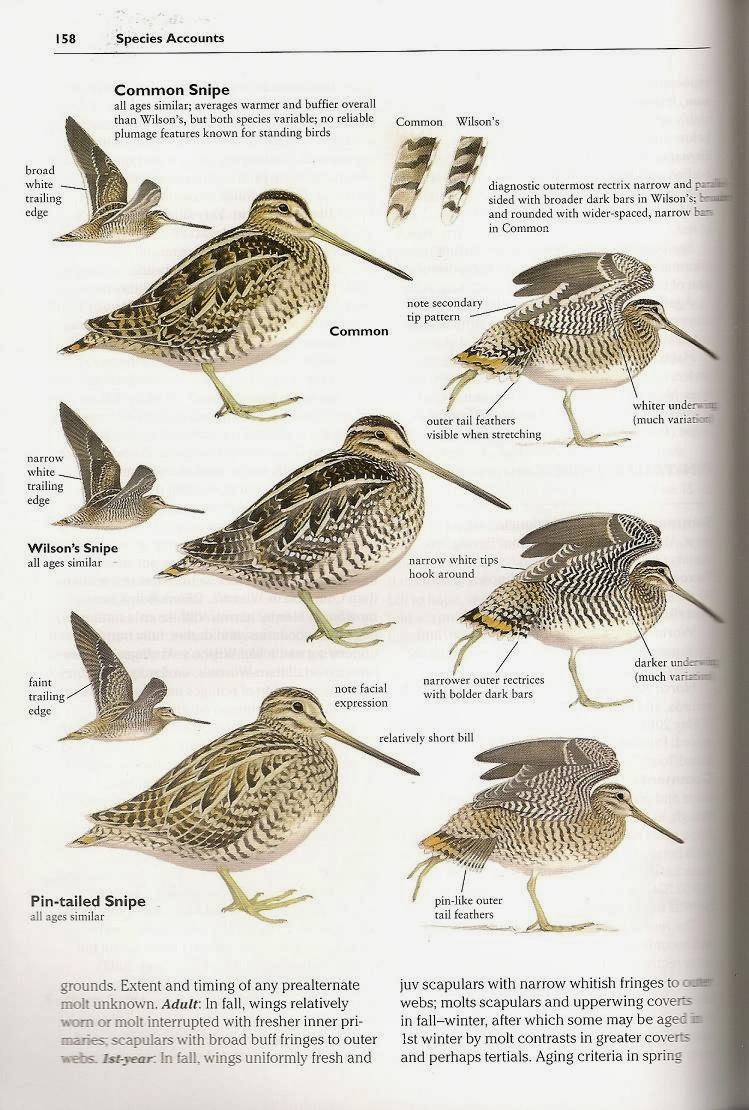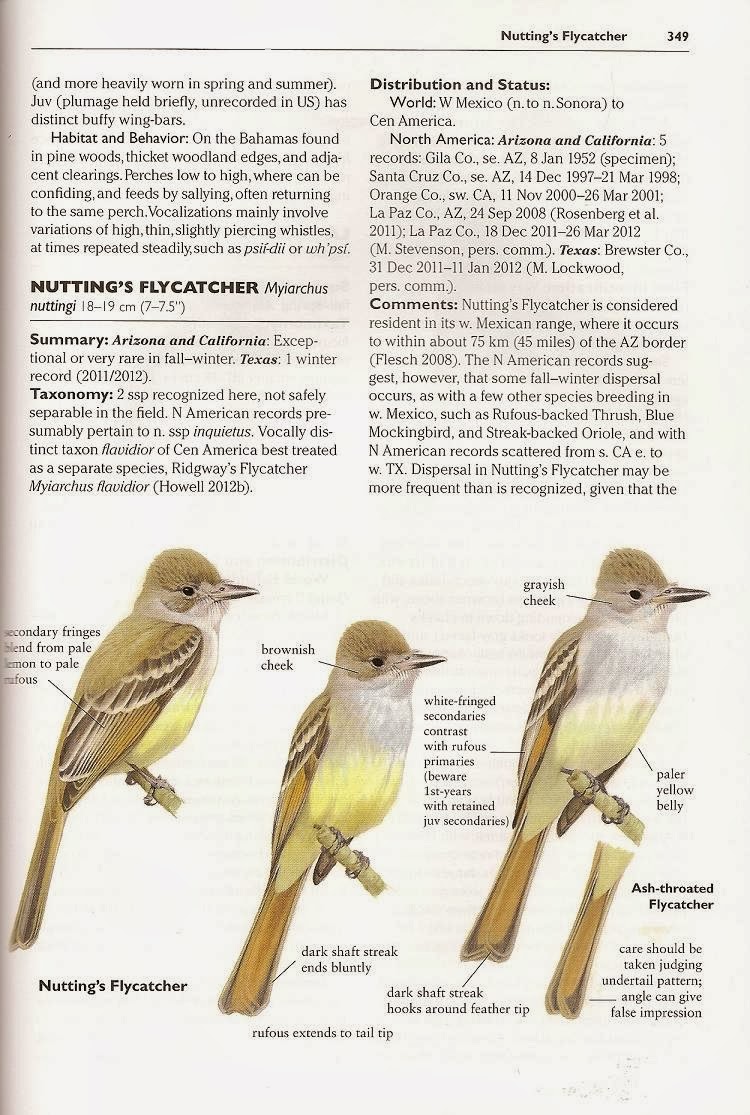Rare
Birds of North America
by Howell,
Steve N.G.; Ian Lewington, and Will Russell
2014, 428pp, ISBN: 9780691117966
Basics: hardcover; a thick reference book with multiple high-quality
illustrations for each of 262 "ultra" rare vagrants in the US and
Canada; text for each bird covers normal distribution ranges, historical
sightings and trends in North America, detailed field identification to include
similar species as well as age and sex, and, notes on habitat and behavior
 (Also available as a digital download
from iTunes). This relatively large book
(10x7x1.5 inches) is an exceptional, first-of-its-kind resource for a niche of
birding not well covered. This book will
be greatly appreciated - and eagerly studied - by avid birders and twitchers
who've jumped in a car (or plane) to see that nemesis rarity; or, by the traveling birder trekking to Arizona and Texas in search of those borderline
rarities. However, the detailed nature
of the material along with historical records might be a little dry (and
overwhelming) to some people that gain sufficient pleasure and excitement from
the local birds coming into the backyard feeders.
(Also available as a digital download
from iTunes). This relatively large book
(10x7x1.5 inches) is an exceptional, first-of-its-kind resource for a niche of
birding not well covered. This book will
be greatly appreciated - and eagerly studied - by avid birders and twitchers
who've jumped in a car (or plane) to see that nemesis rarity; or, by the traveling birder trekking to Arizona and Texas in search of those borderline
rarities. However, the detailed nature
of the material along with historical records might be a little dry (and
overwhelming) to some people that gain sufficient pleasure and excitement from
the local birds coming into the backyard feeders.
There are a four things that define
the scope of this book…
 One:
It is an identification guide but definitely not a field guide due to
the book's size and weight; and, to the large amount of information in the book
not related to identification in the field.
One:
It is an identification guide but definitely not a field guide due to
the book's size and weight; and, to the large amount of information in the book
not related to identification in the field.
Two: A summary is provided of when
and where the rarities were seen along with notes on the bird's status. Additional resources are also given for
further research.
Three: A plethora of multi-decade
experience of identifying these birds is given (in writing and illustrations)
to any eager birder who wants to learn about rare birds that are more often
seen in dreams than in the field.
 Four: The book illustrates what I
call "ultra" rare birds recorded since 1950. The authors define "rare" as five
(5) or fewer sightings per year. This
limit (frequency and time frame) helps to keep this a one-book project versus a
multi-volume effort.
Four: The book illustrates what I
call "ultra" rare birds recorded since 1950. The authors define "rare" as five
(5) or fewer sightings per year. This
limit (frequency and time frame) helps to keep this a one-book project versus a
multi-volume effort.
This book definitely is the best
source for top-quality illustrations of the North American ultra-rarities. The artwork by Ian Lewington is, as usual,
excellent. His skills are some of the
best in any bird book. The birds are
shown with near-perfect proportions, coloring, and intricate detail. These illustrations are additionally
bolstered by the inclusion of seasonal variations, plumage differences of age
and sex, and - for some - comparisons to similar common species. Many of the birds also have ID tips with the
illustrations, helping to point out the key features to be noticed. Nearly all species are shown with 3-5
illustrations. Some, such as the Kelp
Gull, Steller's Sea Eagle, or Western Marsh Harrier, have 9-11 illustrations.
 Within this book, you will see the
most up-to-date use of taxonomic changes and trends. The authors refer to both the IOC and AOU for
naming conventions and for referencing the many subspecies and probable future
splits. Their research into the taxonomy
informs the reader of the 40 subspecies of Bananaquit that probably make up
multiple species; or, Eastern Blue Bunting (of Texas note) that is probably
distinct from the Western Blue Bunting.
Other newer trends are the inclusion of the Hen Harrier (split from
Northern Harrier), Mexican Yellow Grosbeak (from Southern Yellow Grosbeak), and
Mexican Tufted Flycatcher (from South American). One bird I was curious to see how it would be
addressed was the "Stonechat".
The newer and at-large handling of the multiple subspecies can include
distinct species of European, Siberian, African, and Stejneger's. Apparently, all North American sightings
(west and east) are of the Siberian.
Within this book, you will see the
most up-to-date use of taxonomic changes and trends. The authors refer to both the IOC and AOU for
naming conventions and for referencing the many subspecies and probable future
splits. Their research into the taxonomy
informs the reader of the 40 subspecies of Bananaquit that probably make up
multiple species; or, Eastern Blue Bunting (of Texas note) that is probably
distinct from the Western Blue Bunting.
Other newer trends are the inclusion of the Hen Harrier (split from
Northern Harrier), Mexican Yellow Grosbeak (from Southern Yellow Grosbeak), and
Mexican Tufted Flycatcher (from South American). One bird I was curious to see how it would be
addressed was the "Stonechat".
The newer and at-large handling of the multiple subspecies can include
distinct species of European, Siberian, African, and Stejneger's. Apparently, all North American sightings
(west and east) are of the Siberian. If you're wondering what rarities are
not included in this book, some examples are Black-capped Gnatcatcher, Ruddy
Ground-Dove, Bar-tailed Godwit, Shiny Cowbird, and Clay-colored Thrush. While rare, those are found with greater
frequency in the US, if not even being routine.
Other species not included are Worthen's Sparrow and Bumblebee
Hummingbird, which are very, very old records.
Darn. Those are some of the first
birds I looked up. Their records from
the US are mystical to me and I see so little written or illustrated about
those birds.
If you're wondering what rarities are
not included in this book, some examples are Black-capped Gnatcatcher, Ruddy
Ground-Dove, Bar-tailed Godwit, Shiny Cowbird, and Clay-colored Thrush. While rare, those are found with greater
frequency in the US, if not even being routine.
Other species not included are Worthen's Sparrow and Bumblebee
Hummingbird, which are very, very old records.
Darn. Those are some of the first
birds I looked up. Their records from
the US are mystical to me and I see so little written or illustrated about
those birds.
Another group of birds not included
are vagrant European subspecies that may constitute distinct species, some of
which are already considered as such by the IOC. Some examples include the Eurasian
(Green-winged) Teal, Cayanne (Sandwich) Tern, Asian and the European Whimbrels,
Common (Mew) Gull, and Eurasian (Barn) Swallow.
 There is very little in this book
that warrants critique. Only two petty
things come to mind. One, is the species
are arranged a little awkwardly. Instead
of a pure taxonomic order, they're arranged by "Larger Land Birds" or
by "Aerial Landbirds" and then further by Old and New World. This creates a few odd assortments such as
swifts being found before and after the hummingbirds; the Eurasian Jackdaw
shown before the doves; or, the Common House-Martin separated from fellow
swallows by both the swifts and the hummingbirds. The thrushes are broken apart the most, being
separated by 63 pages of Old World warblers, wagtails, pipits, buntings,
finches, and flycatchers.
There is very little in this book
that warrants critique. Only two petty
things come to mind. One, is the species
are arranged a little awkwardly. Instead
of a pure taxonomic order, they're arranged by "Larger Land Birds" or
by "Aerial Landbirds" and then further by Old and New World. This creates a few odd assortments such as
swifts being found before and after the hummingbirds; the Eurasian Jackdaw
shown before the doves; or, the Common House-Martin separated from fellow
swallows by both the swifts and the hummingbirds. The thrushes are broken apart the most, being
separated by 63 pages of Old World warblers, wagtails, pipits, buntings,
finches, and flycatchers. Another nitpick is the random layout
of how each bird's account begins, which can be anywhere on the page. To the extreme, the Citrine Wagtail and Aztec
Thrush have their illustrations and text spread across two pages except for the
bird's name and a few beginning lines.
These are found on the preceding page, tucked in the bottom right
corner. Okay, that's minor; but, I find
my eyes continually darting across the pages as I look for the beginning of
each bird's account.
Another nitpick is the random layout
of how each bird's account begins, which can be anywhere on the page. To the extreme, the Citrine Wagtail and Aztec
Thrush have their illustrations and text spread across two pages except for the
bird's name and a few beginning lines.
These are found on the preceding page, tucked in the bottom right
corner. Okay, that's minor; but, I find
my eyes continually darting across the pages as I look for the beginning of
each bird's account.
Should you get this book? If you are an avid birder excited by
searching for a rarity; or, if you embrace the challenge of learning those
necessary identification features; or, if you are intrigued by the historical
presence of a particular rarity, then you must get this book. There is no better compilation of rarities
with such quality illustrations, completeness of researched records, and
experienced identification.
(written by Jack at Avian Review with
sample pages, February 2014)

See other birding books related to advanced identification and avid birding at this link...HERE.

No comments:
Post a Comment